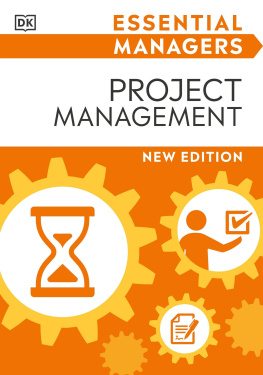Table of Contents
Moving On Up:
Changing Your Approach at the Managerial Level
In this eBook, well discuss how life on the productivitypath will change for you once you step up to the hallowed halls of management.
When you do make the transition (and you will!), you'llfind that while the basic principles that have guided your career thus farstill apply, your approach to them must change. Things look somewhat differentat the managerial level, and your duties and decisions are more encompassingthan ever before. Therefore, to adapt properly to your new circumstances,you'll have to revamp your thinking somewhat.
In this book, I'll provide somepointers on how to:
Manage others, not just yourself;
Juggle multiple projects with many moving parts;
Delegate tasks to maximize your efficiency;
Follow up with your team members and keep them positivelymotivatedwithout micromanaging;
Manage meetings, so they don't eat up your precious time; and
Maintain a positive outlook that pervades your team andconsistently helps you move forward.
Before I get started, I'd like to point out that it would bea mistake to consider any of these factors to be discrete items that can beaddressed in a vacuum. They're all pieces of the same puzzle, and to be trulyproductive, you need to assemble them into a seamless whole that lights thepath ahead. So don't be surprised to hear some of the same notes repeated indifferent sections of this presentation; when you do, you're hearing theunifying theme that underlies it all.
With that said, let's go!
Managing Others as Well as Yourself
When you step up to management, you're no longer on your ownin terms of professional responsibility. Suddenly, a number of other people arelooking to you for guidance, not just in terms of their job responsibilitiesand company policy but also, to some extent, on issues of morality andjudgment. Worse, they're all doing it in their own inimitable styles, which youcan't ignore.
Now, in any bookstore, you'll find dozens of books on how tobe a good manager, and they'll vary according to what the author thinks"good" means. Given our limited venue here, let's boil it down to thesensible and straightforward: to be a good manager, at the very least you needto be honest, trustworthy, reliable, thoughtful, fair, patient, andresponsible. Sounds kind of like the Boy Scout oath, doesn't it?
How you apply all these factors determines how you shapeyour team to maximize its productive capacity. As the leader, it's yourprivilege and responsibility, at least within certain broad guidelines, totinker with your organization until you've got a lean, well-oiled machine thatcan help pull your company profitably into the future. So consider thestructure of your team thoughtfully when you ascend to your position, and startbuilding it toward your productivity goals. As appropriate, be willing toeducate and train the people you have; and when you need to pick new membersfor the team, choose the best available people for the job.
You should always be an active leader, a motivator whompeople can look up to and emulate. It's a big job, and here's where thehonesty, trustworthiness, and reliability come into play: they all help youlead by example. Hone your interpersonal skills and learn to communicatebetter, so that you and your team members can more easily understand eachother; and display your patience through a willingness to work with them andaccommodate their personal styles (again, within certain broad guidelines).Always be evenhandedfavoritism is a productivity killerand be willing tolisten and act on complaints as necessary while maintaining a persistent levelof positivity. (We'll come back to this later). Praise your best workers atevery turn, and provide recognition in visible, obvious ways. A simple "Attaboy!"can work wonders, and so can a nice monetary bonus.
Mutual trust will also go a longway toward enhancing productivity in a team setting. To engender trust, you need to show trust in others. Be openin every way that you can. For example, it's your responsibility to share yourjob responsibilities, relinquishing them to others without excessive oversight(I'll talk more about this later, too). And always be willing to share yourknowledge at all levels, whether that means mentoring employees one-on-one,offering constructive improvement strategies on either team or individualbases, or being punctual about passing on company news. The company's missionand vision, and the team's place within both, should also be communicatedfreely and openly.
Juggling Multiple Projects
While it does happen, it's unusual for any team to bededicated to a single client or project, so you'll most likely find yourselfwith several to juggle. It's critical to stay highly organized when doing so,if only to decrease stress and make sure that things get done on time. As themanager, you absolutely must be aware of the big picture, at least within thecontext of your team; so your first step upon taking control should be tocreate and maintain a master list of your current projects, complete withproject milestones and the resources (human and otherwise) devoted to them.
As with any to-do list, your next step is to prioritize. Sitdown with your crew (and your superiors, as necessary), decide which projectsare the most important, and turn the majority of your attention toward those.While you do have to keep track of everything you're juggling, some of those thingsare more like chainsaws or flaming torches than apples, so you have to givethem more of your focus.
That said, always know the next major action for everyproject, and always be aware of your next deadline. In addition tokeeping a general to-do list of all the projects in play, create a status filefor each project. Microsoft Outlook includes excellent project-trackingfeatures, but you can also use a spreadsheet program like Excel to track yourprojects. At the very least, include the timeline (start date, end date, andmilestones), the personnel and resources dedicated to it, the budget, and thepercentage of completion at any particular time. If it's a large project, it'sa good idea to split it into sub-tasks, each with its own timeline. Create aschedule with ticklers to remind you of mileposts (again, easy to do withOutlook), and, if necessary, a checklist where you tick off items as they'recompleted.
Part of the art of juggling multiple projects is decidingwhich team members to assign to them. This is textbook delegation (see below),but never forget that it's your responsibility to coordinate the projectoverall. Do your best to communicate effectively and require consistentupdates, but not so often that they interfere with productivity. That's textbook micromanaging.
On the client side (whether the client is your boss, anin-house consumer, an end user, or someone in a different company), never"go dark" on a project. When you proactively keep them apprised ofyour progress, not only does it help reassure them that they're not forgotten,it helps keep you and your team on track.
Productive Delegation
Modern business is built on delegation. Managers areintended to be facilitators and overseers; they're not supposed to do everylittle thing they're responsible for, which is a big change for those of uswho've worked our way up from the lower echelons. It's easy to stay stuck inthat self-reliant mode; but to really get things done, you have to share yourauthority. Otherwise, you're just hurting yourself and the company.
Delegation is simply the assignment of authority from onedecision-making level to a lower one: that is, it gives someone else the powerto do something that's nominally part of the manager's job. For reasons ofbudget and efficiency, delegation should always be pushed down to the lowestpossible level.



















